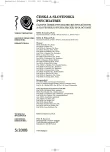Catamnestic Observation of the Efficacy of Substance Dependence Treatment Program
Authors:
A. Tibenská; J. Čížek; C. Martinek; J. Libiger
Authors‘ workplace:
Léčebna návykových nemocí Nechanice
detašované pracoviště Psychiatrické kliniky LF UK a FN, Hradec Králové
přednosta prof. MUDr. J. Libiger, CSc.
Published in:
Čes. a slov. Psychiat., 104, 2008, No. 5, pp. 230-235.
Category:
Original Article
Overview
This is a report on the follow-up survey of the efficacy of the hospital based program for treatment of substance dependence and gambling. at the Hospital for Substance - Related Disorders in Nechanice. We assessed the rate of abstaining patients at the intervals of 6 months, one and two years since the completion of a treatment program with the minimum duration of 60 days. The data were obtained by a questionnaire from the relatives of the patients . Additional information was received from the community therapeutic facilities that were in contact with the patients during the follow-up period.
After 6 months the rate of the complete and lasting abstention was at least 46.4% of patients (60.9% of all returned questionnaires) After one year the minimal abstention rate was 39%(57% of the returned questionnaires) and after two years it was 30.5% (53.5%).We discuss the differences in the abstention rate among various types of dependence and the relationship between the abstention and the type of program closure. We confirmed an association of the successful abstention and continuing psychotherapeutic treatment during the follow-up period.
Key words:
substance dependence on psychoactive drugs, pathological gambling, hospital-based treatment program, abstention, efficacy of substance dependence treatment program.
Sources
1. Csémy, L., Dvořák, V., Kubička, L.: Jsou výsledky ústavní léčby orientované na abstinenci uspokojivé? Psychiatrie, Časopis pro moderní psychiatrii, 9 (suplementum 1), 2005, s. 20.
2. Drug Abuse Treatment Outcome Studies. Stažený 1. května 2007, dostupný z WWW : <http://www.datos.org/>.
3. Feuerlein, W., Kufner, H.: A prospective multicentre study of in-patient treatment for alcoholics: 18 - and 48-month follow up (Munich Evaluation for Alcoholism Treatment, MEAT). Eur. Arch. Psychiatry Neurol. Sci., 239, 1989, 3, s. 144-157.
4. Gossop, M., Marsden, J., Steward, D.: NTORS after five years: The National treatment Outcome Research Study. London, National Addiction center, 2001.
5. Kysilková, J.: Výsledky katamnestického šetření. Prezentováno na semináři AT oddělení v Želivě dne 27. 5. 2005.
6. Simpson, D. D., Joe, G. U., Brown, B. S.: Treatment retention and follow-up outcomes in the Drug Abuse Treatment Outcome Study (DATOS). Psychology of Addictive Behaviors, 11, 1997, 4, s. 294-307.
7. Simpson, D. D., Joe, G. W., Broome, K. M.: A national 5-year follow-up of treatment outcomes for cocaine dependence. Archives of General Psychiatry, 59, 2002, s. 538-544.
8. Skála, J.: Historie léčby závislosti v České republice. In Kamil Kalina a kol. (Eds.): Drogy a drogové závislosti 2. Praha, NMC /Úřad vlády ČR/, 2003, s. 91-95.
Labels
Addictology Paediatric psychiatry PsychiatryArticle was published in
Czech and Slovak Psychiatry

2008 Issue 5
- Hope Awakens with Early Diagnosis of Parkinson's Disease Based on Skin Odor
- Deep stimulation of the globus pallidus improved clinical symptoms in a patient with refractory parkinsonism and genetic mutation
- Memantine Eases Daily Life for Patients and Caregivers
- Memantine in Dementia Therapy – Current Findings and Possible Future Applications
Most read in this issue
- Dissociation in Childhood: Clinical Manifestation and Diagnosis Child Dissociative Checklist
- Catamnestic Observation of the Efficacy of Substance Dependence Treatment Program
- Criminal Liability Assessment in Defendants with History of „Schizophrenia“ - Case Study of Institutional Revision Report
- Circadian Rhythms in Major Depressive Disorder
